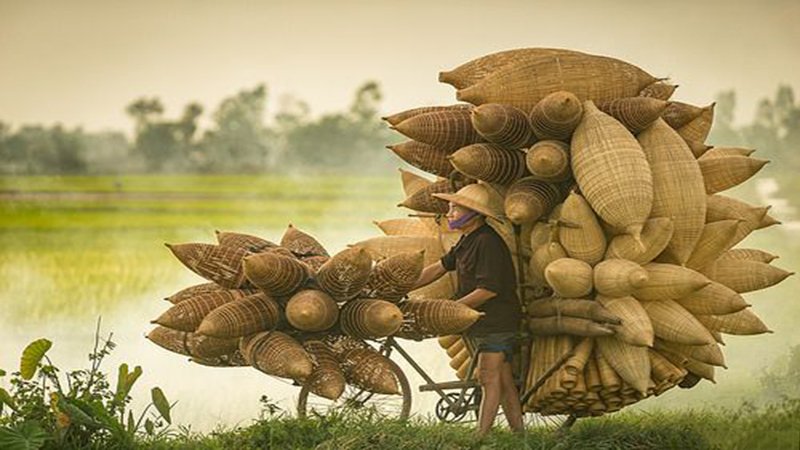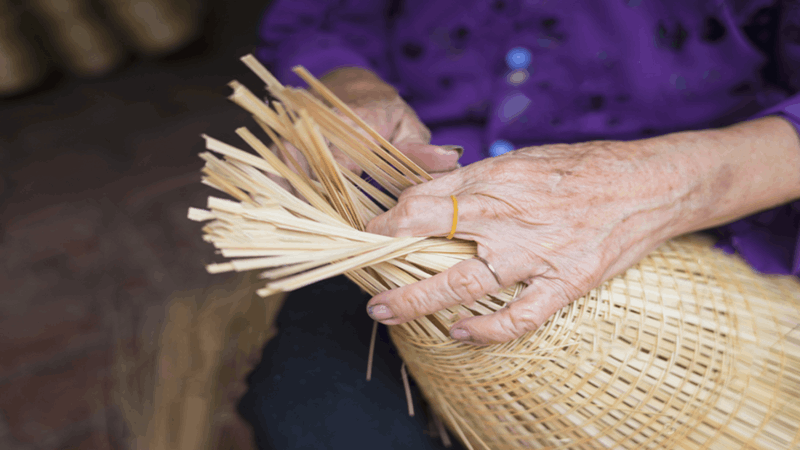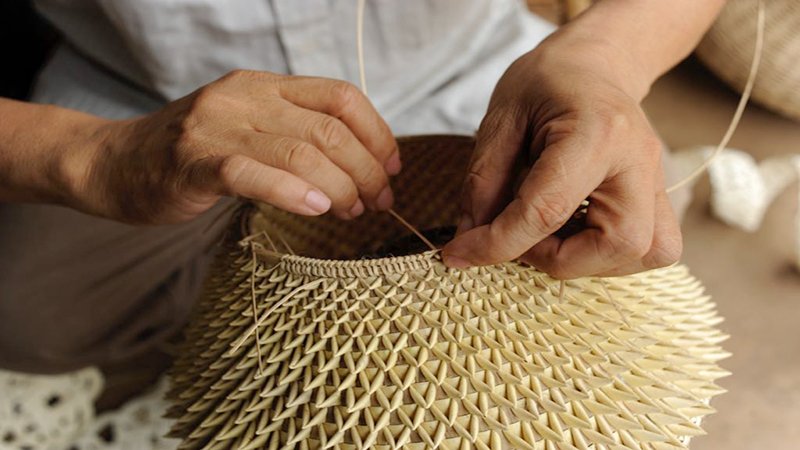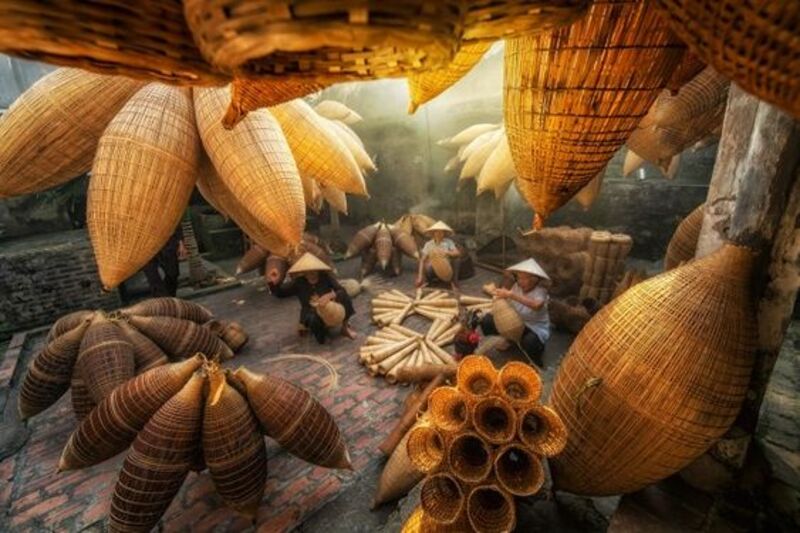No products in the cart.
Blog
Traditional Craft Village In Vietnam Creative Haven
Explore the fascinating world of traditional craft village in Vietnam, where vivid culture and age-old skills come to life. These distinctive communities are thriving centers of innovation and creativity as well as the custodians of the country’s rich artisanal legacy.
We will explore the history, relevance, and contemporary function of these craft villages in this blog, revealing the mysteries underlying their persistent allure and cultural value.
The Beauty of Traditional Village in Vietnam

Vietnam’s traditional craft villages are a tapestry of cultural heritage, where skilled artisans create exquisite handicrafts using time-honored techniques. These villages provide a window into the active communal life and rich history of the nation, frequently situated against peaceful rivers and gorgeous scenery.
The intricate craftsmanship of weaving, pottery, lacquer painting, and wood carving demonstrates the artisans’ skill and the deeply rooted traditions that have been handed down over the years.
How Traditional Craft Village in Vietnam Inspires Us?
Traditional craft villages in Vietnam are lively centers of culture and creativity, inspiring us with their dedication to preserving heritage and fostering community.
- Cultural preservation: They maintain and pass on age-old traditions and skills.
- Community spirit: They foster a strong sense of community and collaboration.
- Sustainability: Emphasis on using natural, locally-sourced materials promotes sustainable practices.
- Creativity and innovation: Craftsmen always innovate in their fields by fusing classic methods with modern designs.
- Economic contribution: They support livelihoods and tourism by contributing to local economies.
- Educational value: They offer learning opportunities for younger generations and visitors alike.
- Aesthetic appreciation: They cultivate an appreciation for the beauty and intricacy of handmade goods.
By demonstrating the value of cultural preservation in the contemporary world, these villages foster a deep appreciation for handcrafted goods.
Challenges Faced by Craft Villages in Vietnam
Despite their rich cultural heritage and artisanal excellence, craft villages in Vietnam face numerous challenges that threaten their survival and sustainability. Here are some challenges:
- Modernization and urbanization: Encroachment of modern development threatens traditional practices.
- Market competition: Competition with mass-produced goods impacts the demand for handmade crafts.
- Sustainability of materials: Difficulty in sourcing traditional materials sustainably.
- Skill transmission: Younger generations may lack interest in learning traditional crafts.
- Economic viability: Balancing between preserving traditions and ensuring economic viability can be challenging.
- Limited access to Markets: Difficulty in reaching broader markets and modernizing sales approaches.
- Funding and investment: Limited financial support for maintaining and promoting craft villages.
- Technological adaptation: Integrating technology without losing the essence of traditional methods.
To preserve the unique cultural and economic contributions of Vietnam’s craft villages for future generations, addressing these challenges is so important.
The History and Significance of Craft Villages

It is essential to maintain the nation’s artisanal traditions and cultural legacy of Vietnam’s craft villages. They have a long and rich history, stretching back centuries.
- Ancient origins: Many craft villages in Vietnam date back centuries, originating from small, self-sufficient communities.
- Cultural heritage: They serve as living museums, preserving traditional techniques, tools, and practices.
- Artisanal skills: These communities are well known for their specialty crafts, including woodcarving, weaving, and ceramics.
- Community identity: Craft villages contribute to the cultural identity and pride of local communities.
- Economic foundation: Historically, they have been the economic backbone for many rural areas, providing livelihoods and trade opportunities.
These communities’ historical and cultural significance highlights how crucial they are to preserving Vietnam’s distinctive handicraft heritage.
The Role of Craft Villages in Modern Society
Preserving cultural heritage, boosting local economies, and fostering community spirit are the benefits that Vietnam’s craft villages can bring in modern society.
- Cultural preservation: They continue to safeguard and promote Vietnam’s rich cultural heritage.
- Tourism attraction: Craft villages draw tourists, enhancing local economies and cultural exchange.
- Economic opportunities: They provide sustainable employment and income for artisans and their families.
- Educational value: For both natives and visitors, these communities provide informative insights into traditional practices.
- Innovation and adaptation: They blend traditional techniques with modern designs to meet contemporary market demands.
- Community cohesion: Craft villages strengthen community bonds and foster collaborative spirit.
Craft villages are still thriving hubs of Vietnamese culture preservation and economic activity in the modern era because they successfully combine tradition and innovation.
Future Prospects for Traditional Crafts Village in Vietnam
Vietnam’s traditional craft villages depend on striking a balance between innovation and preservation. Embracing contemporary technologies, increasing market accessibility, and encouraging environmentally friendly behaviors are essential to help these communities prosper in the future.
To provide the necessary resources and training, support from governmental and non-governmental groups are essential. The rich cultural legacy and artisanal skills will be preserved for future generations through this way, keeping them relevant in a world that is changing quickly.
Major Traditional Craft Villages in VietNam

Vietnam is home to numerous traditional craft villages, each renowned for its unique products and techniques.
- Bat Trang Pottery Village: Known for its exquisite ceramics, Bat Trang has a history that spans over 700 years. A wide range of pottery products, from everyday household items to elaborate works of art are produced by the village.
- Van Phuc Silk Village: Famous for its luxurious silk, Van Phuc has been weaving silk for over a thousand years. Because of their exceptional quality and artistry, the village’s silk items are highly valued.
- Phu Vinh Bamboo and Rattan Village: The village is known for its skillful weaving techniques. It produces many items from bamboo and rattan crafts like baskets, furniture and decorative pieces.
- Dong Ho Painting Village: Renowned for its traditional folk paintings, Dong Ho uses natural materials and techniques to create vibrant and culturally rich artworks. Historical events and rural settings are frequently shown in these paintings.
Traditional craft villages in Vietnam are not just places of production but living museums of culture and tradition. The important aspect of Vietnam’s history, innovation and creativity in the next generation can be protected by supporting these communities.
Conclusion
Traditional craft village in Vietnam are vibrant communities that preserve ancient techniques and cultural heritage. They serve as a reminder of the worth and beauty of handcrafted art in the contemporary world. By helping these communities, we guarantee the survival of their rich customs and knowledge, honoring their history and ensuring these cultural assets have a viable future.
Hello, I am Althea Stone, a devoted enthusiast of handicrafts, finds solace and creativity in the intricate artistry of handmade goods. My passion for crafting extends beyond mere hobby, serving as a gateway to self-expression and a means to infuse everyday life with beauty and ingenuity.

